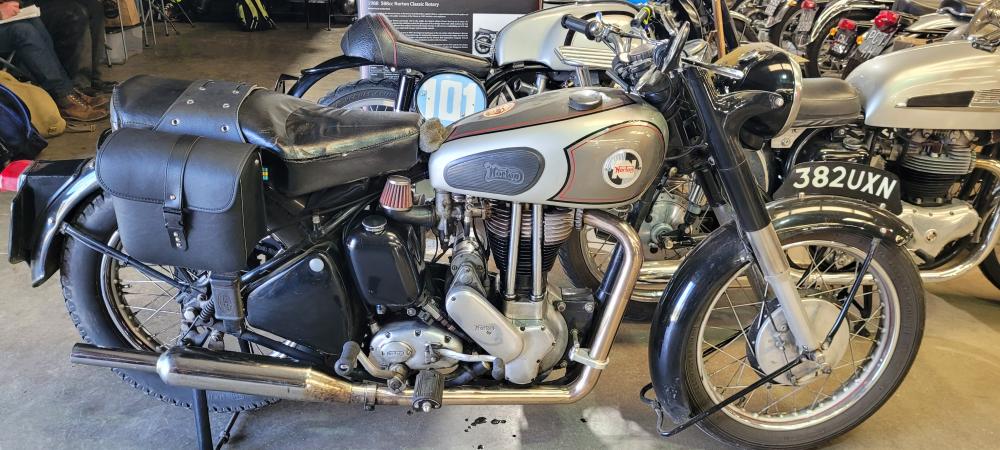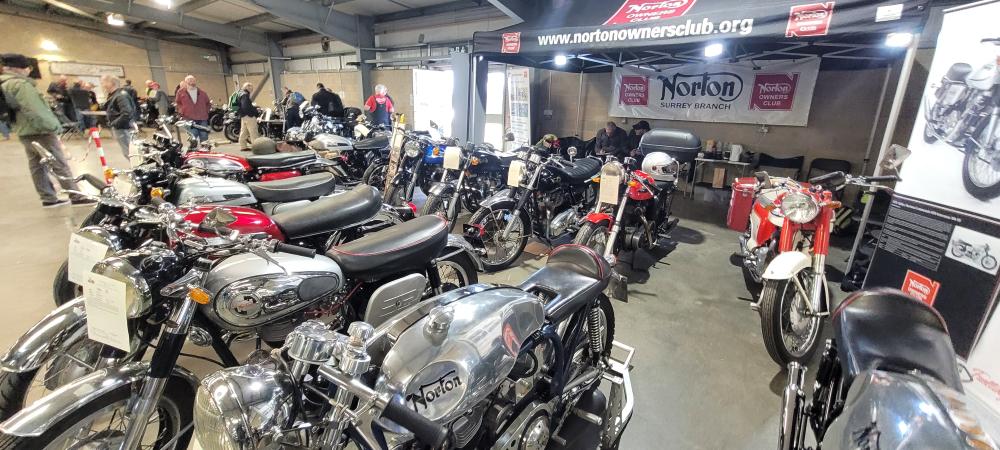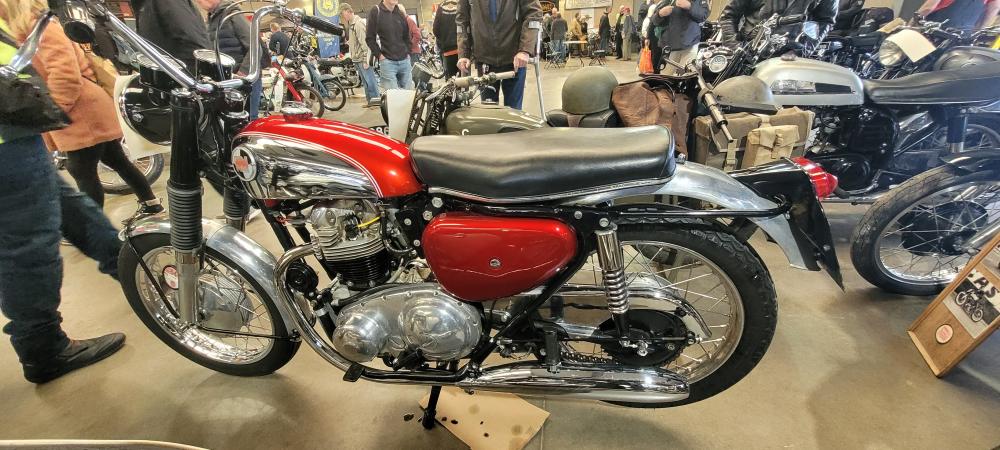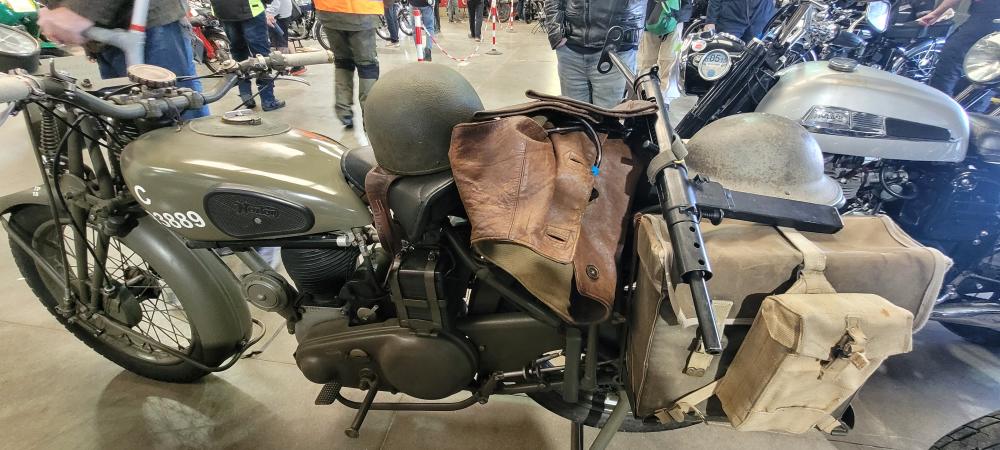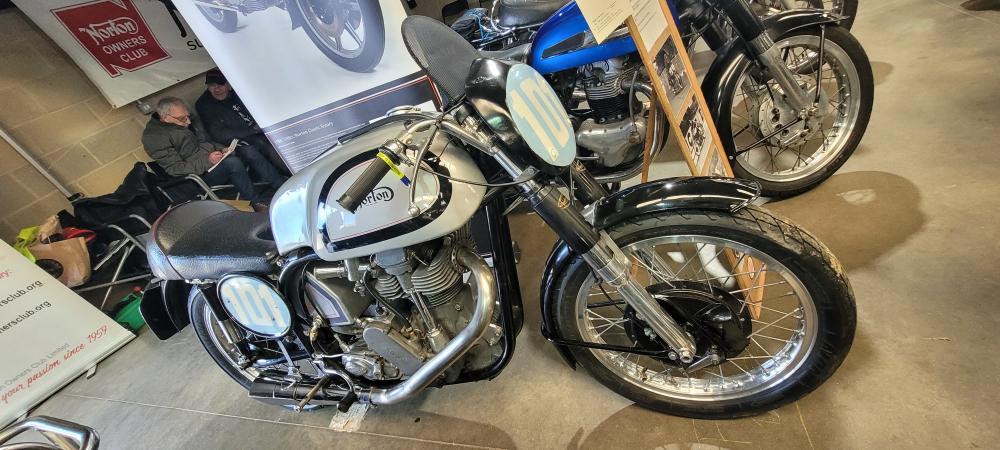THE ATLAS HYBRIDS-Part 1
G.15 Series 1963 to 1967
"When Nortons moved to Plumstead, they had a few Atlas engines left over so they stuck them in Matchless frames". Comment from a 'knowledgeable' spectator at a concours event telling his audience all about a G.15 C.S.R. on display.
They must have had a few more left over than was realised as over seven thousand Atlas hybrids were produced at Plumstead between late 1963 and late 1968. This period of Norton/Matchless production is probably the most confusing five years in the whole history of Norton and AMC. The main reason for this was the number of variants produced from basically two types of machines i.e. the G.15 series and P.11 series, built next to the 'Featherbed' Atlas at the same time. Also nearly all the machines hid behind designation numbers and letters instead of names as was the habit of AMC. Most classic motorcycle enthusiasts could probably describe a Norton Atlas quite well, but ask them to describe a Norton G.15 C.S./N. and they may find this a little more difficult. Let us attempt to unravel a few small mysteries that surround these machines, but first a bit of history, so please pay attention as I will be asking questions later.
Between 1958 and 1960, Norton produced a small number of U.S.A. specification scramblers or desert racers. These used 77 type frames, the 600cc Nomad (approx. 300), N.15 (1958), P.15 (1959) and R.15 (1960) and 500cc Nomad (approx. 40) N, P and R.16. In 1958, Matchless produced the G.11 C.S. 600cc twin and then later the G.12 C.S. 650cc twin, scrambles versions of their C.S.R. road machines. By 1961 the G.12 C.S. was the only scrambler of the aforementioned that was still in production, but it was proving to be unreliable despite of or because of its three main bearing crankshaft. It was also down on power output in comparison with the Triumph Bonneville T120C scrambler.
It was therefore decided to increase the capacity of the engine to 750cc. AMC produced 200 touring models as the forerunners to the intended scramblers. These were designated the G.15/45 models (G.15 Mk.l). However they proved to be even more fragile than the 650cc version when ridden hard, so any thoughts of the scrambler variant were put aside. Frustrating to say the least for AMC who knew there was a huge market in the U.S.A. for powerful desert-racers, to compete in events often 100, 200, 500 and even 1,000 miles in length.
Meanwhile at Bracebridge Street, the Atlas was proving itself after some minor teething troubles, such as the engines blowing up just as its namesake, the Atlas Agaena rocket had done in the U.S.A. a few years earlier). However this was soon corrected and the engine was now fast proving to be reliable, as was the rocket. Back at AMC things were getting worse. Their top of the range road model the G.12 C.S.R. started breaking crankshafts with frightening regularity, as well as camshafts and followers wearing out prematurely. This was certainly not in keeping with the very handsome and sporty lines of the machine.
So we now had this strange situation whereby the beautifully engineered AMC 650cc and 750cc engines were proving to be unreliable when worked hard, and yet their subsidiary company, Norton Motors' 750cc Atlas engines, although a little crude were now reliable and were also producing more power. How embarrassing. So what happened next? Nortons desperately needed a new factory and what is more they had the money to purchase one which they had already inspected. They just required the confirmation to proceed from their parent company.
AMC did not give this. Instead they ordered Norton to send them the 'factory money', closed Bracebridge Street down and moved production of all models to Plumstead. It would be a little naive to think that the two main points in this series of events, i.e. the troublesome engines at AMC and the moving of Norton production to Plumstead were unrelated. However it must be remembered that AMC were now fighting for survival. They already had a proven frame for scrambling, (the Featherbed would break below the headstock) but no reliable engine to power it, then all these Atlas engines and 'Roadholder' forks and wheels mysteriously appeared at Plumstead.
Engine Nos. 107388 to 124371 - Total approx. 5000
In November 1963 a batch of 200 Norton 750 hybrids were leaving the Plumstead factory en-route to the American distributor, Berliner. When they arrived at their destination they would be the first delivery of the new 1964 Norton Atlas Scramblers and were the most powerful production desert-racers ever to be produced at that time. The prototype had already been thoroughly tested on the rough at Hawkstone Park by Chris Horsfield. This was the start of a four-year production run for the Atlas powered G.15 series.
1964 - Nos. 107388 to 110774 : Atlas Scramblers G.15C.S./N and G.15C.S./M : Approx. 1000 built
All these machines used a new frame similar to the G.12 C.S. duplex type with bolt on rear subframe but were fitted with a redesigned malleable steel headstock machined to accept Norton forks and front wheel. The robust swinging-arm was of the Matchless type, but also redesigned to accept a Norton rear wheel.
The arm pivoted on a hardened steel hollow spindle, the outside diameter of which ran in phosphor-bronze 'oilite' bushes pressed into large lugs on each side of the front of the fork. This spindle was supported by its centre portion in a sturdy single cast lug which was pinned and brazed to the vertical tube forming the rear section of the main frame, the spindle being locked in position by way of a cotter. The front forks used stanchions which were 2" longer than the Featherbed version and had special 'Teledraulic' type two-way damping and external springs hidden by steel cover tubes in preference to rubber gaiters, along with standard Roadholder alloy sliders. The forward engine mounting lugs were positioned to accept the latest twin carburettor version of the Atlas engine. The frame/engine numbers followed the Norton system (as did all subsequent hybrids).
The left side crankcase half was machined to take the AMC cast alloy primary chaincase and the gearbox shell was of the A.J.S./Matchless type with the lugs in a different position to the Featherbed shell. The scrambles petrol tank, latest type pear shaped oil tank and battery box were all Matchless items and were painted in the AMC Cardinal Red of the 1961/62 G.12 series machines. (Note to restorers: apart from colour options offered by the distributor, this purple-red was the stock finish and only two prototypes were in silver). The petrol tank used Norton transfers on the sides and had a single black coach-line outlined in white. A straight through exhaust system with slightly upswept ends and no silencers was employed.
Contemporary photographs of a silver prototype sometimes showed the machine with the large AMC silencers. The factory used that same machine to test components for the intended touring model. The mudguards were in chrome and had a centre rib, which were similar to those used on the G.15/45 all Matchless model. This first batch also used non-folding footrests and the Lucas K2FC competition magneto. Subsequent batches had folding footrests and a standard K2F magneto. The reason for the change of magneto apart from cost was that it was very difficult to undo the pickup holder screws due to the close proximity of the gearbox. The machines came complete with a 12 volt lighting system.
As all subsequent G.15 series were based on the Atlas Scrambler we will now carry out an in-depth investigation into the production run and problems encountered on the first machines. It was not long before Mike Patrick the desert-racing star was notching up wins on one of these 420lb. monsters. By July 1964 a total of 600 Norton Atlas Scramblers designed G.15 C.S./N in parts ordering books and 400 Matchless 750 Sports Scramblers designed (and engine stamped) G.15 C.S./M had been produced. The Matchless version was finished in chromatic Candy Apple Red and the petrol tank was silver coach-lined with pinstripe and used the 1959-1962 round plastic badges, the engine numbers commencing at 108638 with the last batches starting to use rubber gaiters on the forks.
All these first machines went to Berliner, the main distributor in the USA. There must have been quite a hectic rush at the factory to get the scramblers built because there were a few 'oversights' on the first batches. One was that it was impossible to remove the cylinder head in situ because even when the exhaust rocker spindles were extracted there still was not enough clearance between the top frame tube, to tilt the head back and withdraw the push rods because the three cylinder head studs were about 1/8" too long, necessitating lowering of the engine. These studs were shortened on all subsequent Atlas engines. Another problem was in the adjusting of the magneto chain or taking off the magneto. Once again because of the close proximity of the gearbox to the engine, the nut on the bottom magneto fixing stud was inaccessible. This of course was not a problem on the Featherbed because of the gearbox being half a mile away from the engine. The factory corrected this with a modification to the right-side crankcase half using a nut and bolt arrangement for the bottom magneto fixing point so that this could now be loosened from inside the timing cover. All subsequent Atlas engines received this. Rushed production also meant that even though the new wider forks were used, the steering anti-theft locks were not available, neither was the new magnetic tachometer. Therefore the first batch went out without the locks and with magnetic speedometers and chronometric tachometers.
Improvements to the next batches were a tighter turning circle achieved by machining more material from the crown 'lock stops' and also longer centre stand feet because it was soon discovered that with scrambles tyres fitted, when the machine was on the stand with the engine ticking over, the bike would creep along on its own and disappear down the end of the road. A most amazing omission was that the inner primary chaincase was only secured at the front. This was by way of the three cheese-headed screws, but the rear was unsupported. This was later corrected by including another stud which secured the centre area to the left engine plate. Even so, these hiccups on the first batch, which were quickly rectified, didn't appear to have dampened enthusiasm for the 'export only' Atlas Scramblers and going by contemporary tests of the machines, they were very well received, probably because most of these errors were in servicing or 'surplus equipment' rather than actual performance in the desert.
1965 - 1967 - Nos. 111926 to 124371 : N.15 C.S and G.15 C.S. : Approx. 2,500 built
1965 to 1966
These later machines were closely based on the Atlas Scramblers but now had modified front fork action, rubber gaiters, and stronger head-steady. The oil tank was 'set in' an extra 1/2" at the front to suit the slimmer sports seat which was also used on the earlier G.12 C.S./C.S.R. models. The Norton was now named the N.15 C.S. and the engine number was preceded by this designation. The Matchless was named and engine stamped G.15 C.S. which was the identical stamping for early Norton Atlas Scramblers, ensuring mayhem for later restorers. Both machines were now identical in Candy Apple Red, only the plastic tank badges being different although the Matchless now used the new 'winged' items. Some of the smaller batches were finished in non-chromatic blue or chromatic green.
1966 to 1967
Another cosmetic re-vamp included less bulky mudguards without the centre rib, the new side-bulge badge area petrol tank and a more modern looking seat without piping but with a plastic-chrome bottom edging. The forks now had internal springs but by this time the machine was a 'Street Scrambler' and had long lost its 'Atlas Scrambler' tag, with both versions now using Norton silencers. So the true Norton Atlas Scramblers were only the six hundred up to July 1964 and finished in Cardinal Red. The first batch of two hundred which had engine numbers stamped G.15 C.S. 107388 to 107588 would presumably be the most collectable being more individualistic. All 750 hybrids had the frame numbers stamped vertically in line down the left side of the headstock but early Atlas Scramblers had each individual number stamped sideways but still in a vertical line.
1964 - 1967 Nos. 109038 to 123570 : G.15 Mk.ll, G.15P, and 33 : Approx. 1000 built
G.15 Mk.ll
At the same time when the original Atlas Scramblers were being produced, a touring version based on these machines was planned for mid-1964. These had a four gallon Matchless tank usually in black with a coach-line and pinstripe in a zigzag flash, and large 'knee-knocker' cast badges (which were replaced in 1965 with the 'winged' plastic items), large deeply-valanced chrome mudguards, conventional exhaust system with the large AMC silencers and were traditionally European styled. The machine used the same frame as the scrambler models but the front forks although still extended two inches had Roadholder damping and internal springs. It was an excellent sidecar machine. The designation was G.15 Mk.ll to differentiate it from the discontinued all Matchless G.15/45 tourer. Confusion was still to occur in the future for restorers however, because early batches were crankcase stamped G.15 C.S. XXXXXX M2. The C.S. stamping was dropped in 1965 and later that year the M2 stamping was also discontinued. The Mk.ll continued production until 1967 with some export machines having a chrome-sided petrol tank finished in Candy Apple Red.
G.15P
This was a single seat version of the Mk.ll produced in small numbers during 1964, presumably for 'forces' work. The mudguards used would differ if the machine was to be an 'export' or 'home' model and whether it was to be designated a Norton or Matchless i.e. G.15P/N or G.15P/M. The guards therefore could be either painted or chrome, and could be the G.15 Mk.ll type or the lighter ES2 Mk.ll type. (Note to restorers: in 1964, parts for the G15 Mk.ll were listed under G.15P).
33
From 1965 to 1967 an A.J.S. version was produced, named the 'Model 33'. It was finished in either black or chromatic blue. The petrol tank had a gold zigzag flash and the motifs were the large cast items changing to the smaller plastic 'diamond' shaped badges for 1966. Only about 50 machines were produced. The engine number was stamped 33.
1965 - 1967 Nos. 112476 to 123465 : G.15 C.S.R. and 33 C.S.R.
Approx. 500 'café-racer' types + 100 others
In November 1964 at the Earls Court show there appeared another variant. This prototype machine was the forerunner for the flagships of all Atlas powered hybrids. It was a sports model in 'café-racer' trim with the designation G.15 C.S.R. An A.J.S. version in chromatic blue was to be the 33 C.S.R. and in the USA the distributor Berliner would sometimes change the Matchless badges to Norton, calling the machine the Norton S/S 750.
The 1965 production models had swept back exhaust pipes (the only stock motorcycle from any manufacturer to offer these as standard equipment) with the large Matchless silencers. Only the show prototype 'café-racer' had Norton silencers. A large 4 gallon chrome-sided petrol tank in Candy Apple Red was fitted which was possibly the most pleasing tank ever produced in the mid-sixties (from 1966 the G.15 Mk.ll also used this tank on export machines). The A.J.S. 33 C.S.R. was finished in chromatic blue but only about 50 of these were produced. The racing image continued with 12.9" rear suspension units (the C.S. used 13.4") with top covers chromed and bottom covers removed exposing the plated reverse-coil springs, rearset footrests, short rear-brake pedal, rear-facing gear change lever with reverse camplate inside the gear-box thus allowing normal selection, polished dural mudguards and the AMC sports seat all ensuring the machine looked capable of exceeding 'the ton'.
Fast it was, with one electronically timed highest one-way speed of 115 mph (on 7.6:1 pistons) in a contemporary road test of what now appears to be one of the most collectable sports machines to own. The C.S.R continued production through 1966 (when the 18" wheels were changed to 19", thus slightly increasing the gearing as both sizes used 3.50 rear tyres) until early 1967. The last 'café-racer' was 120511. After this the 33 C.S.R. was dropped and the Matchless lost its 'café-racer' status, (a sure indication that the Rocker period had passed) and coil/Concentric models with standard footrests and normal exhaust-pipes using Norton silencers converted the machine into a 'sports tourer' (approx. 50 produced). The 'café-racer' C.S.R. machines did not use Norton silencers because of clearance problems with the positioning of the rearset items.
However an unusual final batch in mid-1967 was produced. The large petrol tank was replaced with a 2 gallon scrambles item but with chrome sides, and with high 'ape-hanger' handlebars the C.S.R. capitulated as an American styled 'street machine' (approx. 50 produced).
During this period the Matchless engined 650cc G.12 C.S.R. had finally been made more reliable by the fitting of a 'nodular' crankshaft, stellite tipped cam followers and increased oil pressure, but it all came too late and they had lost the good name and status to the G.15 C.S.R. but rather interestingly from 1964 they also used Norton forks and wheels and were styled more as a tourer. (Note to restorers: the frames used on these machines whilst looking identical to the G.15 frames of the same years, are however different in that the engine mounting lugs are positioned for the Matchless engines).
So it now becomes more obvious why these hybrids were produced. The only true comparison between the Featherbed models and the G.15 hybrids would be to put a Norton Atlas next to a Matchless G.15 C.S.R. as it would be a sensible question to ask why these two machines were produced at the same time. The answer may be 'badge allegiance' but I will try to compare the differences in actually using them from 'memorable' experiences gained at the time they were produced. The machines were a 1961 G.12 C.S.R., then a 1964 Norton Atlas ordered untuned (but with rear-set footrests, ace bars and 19" rear wheel with G.P. tyre) from Paul Dunstall and finally a 1967 G.15 C.S.R. café-racer.
Bearing in mind the scrambler parenthood of the G.15 C.S.R. frame, it is quite amazing that it had any high-speed road-holding qualities at all. In fact, properly set up it was very good, better than the G.12 C.S.R. and almost on a par with the Featherbed at speed and on fast bends. "Aha" I hear you shout, "that's because it had Roadholder forks". However, lower down the speed scale the Featherbed was more 'flickable' for roundabout 'sweeping' and more sure-footed in the wet. Both frame types are stretched to the limit with the power of the Atlas engine as Paul Dunstall had discovered and he subsequently used 'Low-Boy' and then special frames for his Atlas engined 'Domiracer 750' machines.
On really quick bends the Featherbed had a controlled 'drift' whilst the G.15 C.S.R. had a tendency for a slight rear-end weave. Vibration was similar but slightly less on the G.15 C.S.R. for some unknown reason but neither were excessive in this. The vibration (only at high revs) on the Matchless engined G.12 C.S.R. however was high-pitched, sonic and destructive, yet for normal use this machine was the least fussy of the three, albeit with less power available.
Servicing was easier on the Featherbed but the alloy chaincase on the C.S.R. was a better arrangement, however bearing in mind the machines were new, there were no oil leaks from the Norton chaincase either. The Matchless was more comfortable on long journeys or when carrying a pillion passenger but the Norton was more easy to manoeuvre in traffic conditions. The Atlas centre-stand foot-peg had to be cut off for safety on fast corners but even so the Featherbed would still ground before the C.S.R. Exhaust notes were all very 'healthy,' but I must confess a preference for the deep 'burble' of the Matchless 650 engine.
Styling is more of a personal requirement; perhaps the smooth lines of the Norton Atlas or the aggressive lines of the C.S.R. reflect the hidden personality of the owner. Should anyone own both an Atlas and a G.15 C.S.R., Hycam can now offer psychiatric help. Note: take care not to interchange the rear wheel spindle spacers of these two machines - they are of different lengths. Therefore it would appear that personal taste played (and still plays) a large part in the comparison of two of the fastest machines of that time.
AMC employed 'series production' during this period which meant that improvements, modifications and new styling would be introduced into the next batch of machines, instead of waiting for the traditional 'show' time, therefore there will be many instances of overlap with intermediate models to the stated changes in this article. However the introduction of the six-start oil pump gears, and the change from magneto and Monoblocs to coils and Concentrics occurred at the same time on the G.15 series as on the Featherbed Atlas.
The chromatic paint finishes referred to (e.g. Candy Apple Red) were achieved by applying the top colour over a silver base giving a transluscent effect and thus the more coats applied - the deeper the shade. This sometimes caused shadowing if the colour was not applied evenly and also caused variations in the shade from batch to batch.
Perhaps it would be in order here to compare the differences in performance with a standard Atlas engine fitted with magneto and Monoblocs and then coil and Concentrics. There is no question to my mind that the magneto/Monobloc set-up provides far more flat-out power reflected in overall quicker performance but with a price to pay. Coil/Concentrics make for easier 'hot' starting, smoother performance, a more even tickover and far better fuel consumption. However, my own preference is for magneto and opposite Monoblocs 389/689 because assuming the carburettor bodies are not distorted, (sometimes they distort only when hot causing all manner of problems), then you have a compromise with good performance and reasonable fuel consumption.
The early twin-carb. Atlas engine with two 389 bodies, the right-hand one having the fuel chamber chopped off, were exceptionally heavy on fuel. The 1964 Atlas described had this arrangement and with the air-filter removed, the main jets recommended were 440 returning a consumption figure under hard riding of 35 mpg. But did it go. On several occasions under favourable conditions it pulled 6800 rpm in top (without clutch-slip) giving 117 mph. The main jets for opposite Monoblocs 389/689 should be about 360, returning about 50 mpg on average riding, and for Concentrics the jets should be about 260, returning about 60 mpg.
And so by mid-1967 the G.15 series had come to an end. Many unsold machines were put into stock and later sold as 1968 models. A few were even registered in Britain as late as 1970, a good indication that the series had overrun its time. But back to 1967, the hybrid builders at AMC, or by this time Norton-Villiers had not quite finished yet. With a flourish of activity they planned and produced another series of hybrids that were completely different from previous machines but still used the Atlas engine for power and although production was short-lived, they were even more spectacular and caused just as much confusion to restorers many years later - the notorious P.11 series.
| Highest speeds on standard gearing under favourable conditions, (but not sustainable) |
||||
| Engine Sprocket |
Gearbox Sprocket |
Model | Speed | Rear Tyre |
| 21 | 19 | Norton Atlas | 110 mph @ 6400 rpm (M) | 18 x 4.00 19 x 3.50 |
| 21 | 17 | N.15 C.S. and G.15 C.S. | 100 mph @ 6400 rpm (M) | 18 x 4.00 |
| 22 | 17 | G.15 Mk.ll | 104 mph @ 6400 rpm (M) | 18 x 4.00 |
| 22 | 19 | G.15 C.S.R. | 115 mph @ 6600 rpm (M) 116 mph @ 6400 rpm (M) |
18 x 3.50 19 x 3.50 |
| 22 | 19 | G.15 C.S.R. (U.S.A.) | 106 mph @ 6000 rpm (C) | 19 x 3.50 |
| 21 | 19 | P.11 | 105 mph @ 6200 rpm (C) | 18 x 4.00 |
|
M = magneto/Monoblocs C = coils/Concentrics
|
||||
These figures are based on electronically timed speed tests. It should be remembered that these were stock twin carb. machines with gearing and riding positions as delivered. It is often not fully appreciated that gearing/riding position can alter the top speeds using the same engine by over ten miles per hour- As a general rule a machine later fitted with small-bore exhaust-pipes, low bars and rear-set footrests will increase the top speed quoted by approx. 3 mph (apart from the G.15 C.S.R. 'café racer' which had this set-up as standard equipment). A dolphin type fairing would give another 3 mph or a full dustbin 6 mph. Realistic short period top-speeds would be approx. 10 mph less than the quoted figures and long period top-speeds approx. 20 mph less with comfortable cruising at approx 35 mph less. The maximum power is at 6400 rpm with a safe maximum at 6800 rpm although this is not attainable in top gear on standard machines.
Cruising speeds should be just above or below the 4500 rpm vibration peak. Atlas crankshafts should never be dynamically rebalanced if they are to be used on the road. They already have an 80% balance factor and any further balancing will only shift the vibration period to a different range. If this period comes in at your chosen cruising speed, just alter the gearing. It is not recommended that P.11 series machines be converted to café-racing specification and used as such. You will fall off and anyway there aren't enough cafés left to race to. Should much higher top-speeds than those quoted be claimed, then the machine either had clutch-slip whilst the tachometer was being read or a tuned-up speedometer was fitted. The fitting of 9:1 pistons alone will make the engine less tractable at low speeds, may increase mid-range acceleration but will not increase the absolute top-speed. However it may lengthen the time that the non-sustainable top-speed can be held. Tappet clearances should be increased by .002" (.05mm). It is also recommended that a 'Superblend' type main bearing be fitted to the drive-side. Should a Superblend also be fitted to the timing side in place of the original type ball race, check crankshaft end float as per manual. Should a complete Commando engine be put into a Featherbed or hybrid frame, the crankshaft must be changed to the Atlas balance factor.
| Ignition timings (fully advanced) | ||
| 7.6 : 1 | Concave crown | 32 degrees b.t.d.c. |
| 9.0 : 1 | Flat crown | 28 degrees b.t.d.c. |
© Hycam
Originally published in the Norton Owners Club Classic Calendar for 1994

